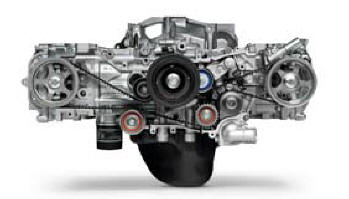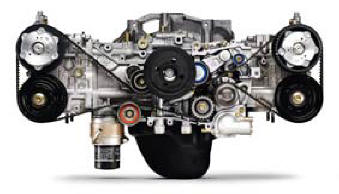|

2.5-liter Flat-4
Two available 170-horsepower 4-cylinder engines combine capable power, efficiency, and impeccably smooth operation.
-
170 hp (standard) dependent upon model year selected (compare with a standard 60hp VW engine)
Subaru 2500cc (2.5L) SOHC, four cylinder, 2 cam fuel injected, water-cooled (170hp @ 5500rpm; 166 lb-ft Torque@4000 rpm; 87 octane regular fuel)

2.5-liter Turbo
The intercooled, turbocharged 2.5-liter engine comes in many versions, with each one delivering a punch of performance.
-
230-265hp Turbo GT/WRX/Legacy GT (optional)
Subaru 2500cc (2.5L) DOHC, four cylinder, 4 cam fuel injected, water-cooled (230-250hp @ 5500rpm, 236 lb-ft Torque@4000 rpm; 91 octane fuel)
|
Our Subaru engines have not been modified in any way to achieve their horsepower ratings. They were designed by Subaru to be used in the OEM automobile environment across the globe enduring all weather and driving conditions in much heavier cars than our 356A models. The durability and performance reliability of these engines is known worldwide especially in the brutal road racing World Rally Championships (WRC) arena of which Subaru has been World Champion several times. You can enjoy the exhilaration of a "high performance" car without the risk or cost of a highly modified engine. To test this philosophy ask what warranty is provided with a highly modified VW engine.
|
These are "useful" horsepower and
torque ratings using regular grade fuel, and occur within engine rpm
levels normal drivers never exceed. Paying for "useless" power
above this RPM range is costly, unnecessary, and risky.
Higher Horsepower figures and performance are achievable with 93 octane premium fuel. You can safely switch between low-mid-high octane fuels. Since the OBD II engine control system computer automatically adjusts engine timing to the highest level possible the advantages of higher octane fuels can be realized. |
Timing advance is the only way gains from octane increase can be achieved. Conversely,
if
you happen to buy some "bad" gas the computer protects your engine
from detonation and possible damage.
VW Beetle engines do not have these protections. Their distributors are static and cannot make these automatic and critical adjustments: therefore, timing for VW's must be set for the least common denominator (lower 87 octane fuel) for fear of detonation and piston destruction. Higher octane fuels are a waste in engines whose timing cannot be advanced to take advantage of them. This is why you cannot get a warranty on a VW engine built other than stock. Advertised horsepower/torque ratings for high performance VW engines are usually measured using 93 octane fuel...what would they be with 87 octane fuel ? |
Transaxle Choices: these specifications can vary from model and year choice
|
Subaru 4-speed automatic overdrive with electronic shift controls, floor shifter, oil cooler, 4.11 final drive ratio
(2475rpm at 60mph 4th gear; passing down shift at 60mph develops 3600rpm which is just below the engine's peak torque rating 165 lb-ft at 4000rpm i.e. full torque available for passing)
|
Subaru 5-speed manual shift overdrive, 3.89 final drive ratio- OPTIONAL (2580rpm at 60mph 5th gear; passing down shift at 60mph develops 3500rpm which is just below the engine's peak torque rating 165 lb-ft at 4000rpm i.e. full torque available for passing)
|